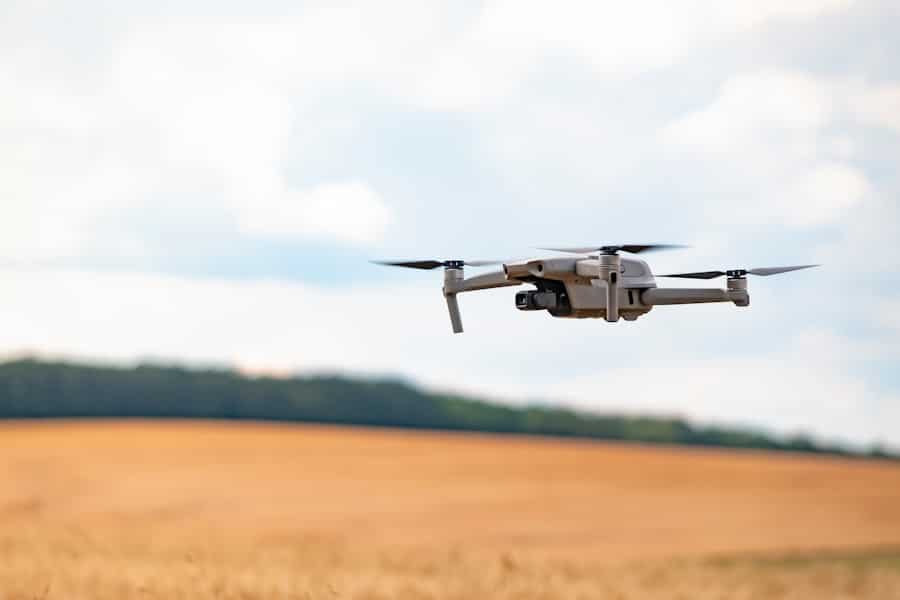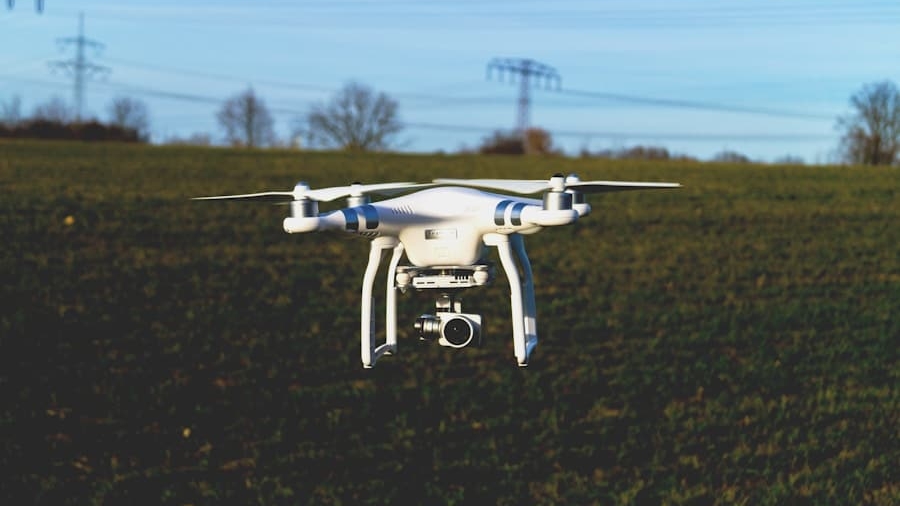The integration of artificial intelligence (AI) with drone technology has revolutionized various sectors, and agriculture is no exception. In the realm of livestock management, the application of AI-driven drones has emerged as a transformative force, enhancing efficiency, productivity, and sustainability. Drones equipped with advanced sensors and AI algorithms can monitor livestock health, track movements, and manage grazing patterns with unprecedented precision.
This technological synergy not only streamlines operations but also provides farmers with actionable insights that were previously unattainable through traditional methods. As the global demand for food continues to rise, the pressure on livestock producers to optimize their operations intensifies. The traditional methods of livestock management often involve labor-intensive processes that can be time-consuming and prone to human error.
By harnessing the capabilities of AI in drone technology, farmers can automate many of these tasks, allowing them to focus on strategic decision-making rather than routine monitoring. This article delves into the myriad benefits, applications, challenges, and future trends associated with AI in drone-based livestock management, providing a comprehensive overview of this innovative approach.
Key Takeaways
- AI in drone-based livestock management offers improved efficiency and accuracy in monitoring and managing livestock.
- Using AI in drone-based livestock management can lead to better decision-making, cost reduction, and increased productivity.
- AI can be applied in drone-based livestock management for tasks such as monitoring animal health, behavior, and environmental conditions.
- Challenges of using AI in drone-based livestock management include data privacy, regulatory compliance, and the need for skilled personnel.
- Integrating AI with other technologies such as IoT and big data analytics can further enhance the capabilities of drone-based livestock management systems.
Benefits of Using AI in Drone-Based Livestock Management
One of the most significant advantages of employing AI in drone-based livestock management is the enhancement of data collection and analysis. Drones equipped with high-resolution cameras and thermal imaging sensors can capture vast amounts of data over large areas in a fraction of the time it would take a human. This data can be processed using AI algorithms to identify patterns and anomalies in livestock behavior, health, and environmental conditions.
For instance, AI can analyze images to detect signs of illness or distress in animals, enabling early intervention and reducing mortality rates. Moreover, the use of drones allows for real-time monitoring of livestock movements and grazing patterns. This capability is particularly beneficial for extensive farming operations where animals roam over large pastures.
By utilizing AI to analyze movement data, farmers can optimize grazing strategies, ensuring that pastures are not overgrazed and that livestock have access to adequate nutrition.
Applications of AI in Drone-Based Livestock Management

The applications of AI in drone-based livestock management are diverse and continually evolving. One prominent application is health monitoring, where drones equipped with thermal imaging can detect variations in body temperature among livestock. Elevated temperatures may indicate illness or stress, prompting farmers to investigate further.
Additionally, drones can be used to monitor feeding behavior and identify animals that are not eating adequately, which could signal health issues or social dynamics within the herd. Another significant application is in the realm of breeding management. Drones can assist in identifying estrus cycles in female livestock by observing behavioral changes associated with mating readiness.
By integrating AI algorithms that analyze these behaviors, farmers can optimize breeding schedules and improve reproductive outcomes. Furthermore, drones can facilitate the tracking of genetic traits within herds by monitoring lineage and performance metrics over time, allowing for more informed breeding decisions.
Challenges and Limitations of AI in Drone-Based Livestock Management
Despite the numerous benefits associated with AI in drone-based livestock management, several challenges and limitations must be addressed. One primary concern is the initial investment required for drone technology and AI systems. While costs have decreased over time, acquiring high-quality drones equipped with advanced sensors and software can still represent a significant financial burden for small-scale farmers.
This financial barrier may limit access to these technologies for some producers, potentially widening the gap between large agribusinesses and smaller farms. Additionally, there are technical challenges related to data management and analysis. The vast amounts of data generated by drones necessitate robust data storage solutions and sophisticated analytical tools.
Farmers may require training to effectively interpret the data collected by drones and integrate it into their decision-making processes. Furthermore, issues related to connectivity in rural areas can hinder real-time data transmission, limiting the effectiveness of drone operations in certain regions.
Integration of AI with Other Technologies in Drone-Based Livestock Management
The potential for integrating AI with other technologies further enhances the capabilities of drone-based livestock management.
IoT sensors placed on livestock can provide continuous data on vital signs such as heart rate and activity levels.
When this data is analyzed alongside drone-collected information, farmers gain a holistic view of their herd’s health and behavior. Moreover, geographic information systems (GIS) can be integrated with drone technology to create detailed maps that inform pasture management decisions. By analyzing spatial data alongside livestock movement patterns, farmers can identify optimal grazing areas and implement rotational grazing strategies that promote pasture recovery.
This integration not only enhances productivity but also supports sustainable farming practices by minimizing environmental impact.
Future Trends and Developments in AI for Drone-Based Livestock Management

As technology continues to advance, several trends are emerging that will shape the future of AI in drone-based livestock management. One notable trend is the increasing use of machine learning algorithms that enable drones to learn from historical data and improve their monitoring capabilities over time. These algorithms can adapt to changing conditions within herds or pastures, providing farmers with increasingly accurate insights.
Another trend is the development of autonomous drones capable of performing complex tasks without human intervention. These drones could be programmed to conduct routine health checks or monitor grazing patterns autonomously, significantly reducing labor costs and increasing operational efficiency. As regulatory frameworks evolve to accommodate these advancements, we may see a shift towards fully automated livestock management systems that rely heavily on AI-driven drones.
Ethical and Legal Considerations in the Use of AI for Drone-Based Livestock Management
The deployment of AI-driven drones in livestock management raises several ethical and legal considerations that must be carefully navigated. Privacy concerns are paramount; as drones collect extensive data on livestock behavior and farm operations, there is a risk that this information could be misused or accessed without consent. Farmers must ensure that they comply with data protection regulations while also being transparent about how they collect and utilize data.
Additionally, ethical considerations surrounding animal welfare must be addressed. While drones can enhance monitoring capabilities, there is a responsibility to ensure that their use does not cause undue stress or harm to livestock. Farmers should be trained in best practices for drone operation to minimize disturbances during monitoring activities.
Furthermore, as AI systems become more autonomous, questions arise regarding accountability—who is responsible if an automated system makes a decision that negatively impacts animal welfare or farm operations?
Conclusion and Recommendations for Implementing AI in Drone-Based Livestock Management
Implementing AI in drone-based livestock management presents a wealth of opportunities for enhancing productivity and sustainability within the agricultural sector. To maximize these benefits, farmers should consider investing in training programs that equip them with the skills necessary to interpret drone-collected data effectively. Additionally, collaboration among stakeholders—including technology providers, agricultural organizations, and regulatory bodies—will be essential to address challenges related to cost, connectivity, and ethical considerations.
As the landscape of agriculture continues to evolve with technological advancements, embracing AI-driven solutions will be crucial for farmers seeking to remain competitive in an increasingly demanding market. By leveraging the capabilities of drones equipped with AI technology, livestock producers can not only improve their operational efficiency but also contribute to a more sustainable future for agriculture as a whole.
In a related article, Best Software for Furniture Design, the focus is on exploring the various tools and programs available for designing furniture. Just like the use of AI in drone-based livestock management streamlines processes and improves efficiency, the right software can greatly enhance the design and production of furniture. By utilizing advanced technology and innovative software solutions, designers can create stunning and functional pieces that meet the needs of consumers. Both articles highlight the importance of leveraging technology to optimize operations and achieve better results in their respective fields.
FAQs
What is AI?
AI, or artificial intelligence, refers to the simulation of human intelligence in machines that are programmed to think and act like humans. This includes tasks such as learning, problem-solving, and decision-making.
What is drone-based livestock management?
Drone-based livestock management involves using drones to monitor and manage livestock on farms. This can include tasks such as tracking the location of animals, monitoring their health and behavior, and managing their grazing patterns.
How does AI play a role in drone-based livestock management?
AI plays a crucial role in drone-based livestock management by analyzing the data collected by drones to provide insights and make decisions. AI algorithms can process large amounts of data to identify patterns, detect anomalies, and make recommendations for managing livestock more effectively.
What are the benefits of using AI in drone-based livestock management?
Using AI in drone-based livestock management can lead to more efficient and effective management of livestock. It can help farmers make data-driven decisions, improve animal welfare, optimize grazing patterns, and ultimately increase productivity and profitability.
Are there any challenges or limitations to using AI in drone-based livestock management?
Some challenges of using AI in drone-based livestock management include the need for reliable data connectivity in rural areas, the potential for technical issues with drones and AI algorithms, and the need for proper training and expertise to effectively use AI technology. Additionally, there may be concerns about data privacy and ethical considerations when using AI to monitor and manage livestock.


Add a Comment